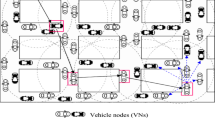Abstract
Connectivity and spatial frequency reuse are very important performance influencing factors in Vehicular Ad-hoc NETwork (VANET). In proposed work connectivity in VANET is measured in terms of Vehicular Average Connected Coverage (VACC). Interference on road is measured in terms of Average Highly Interference Region ratio (AvgHIR). A new Adaptive Transmission and Clear Channel Assessment (CCA) Power scheme (ATCCAPsch) is proposed. ATCCAPsch varies Transmission Range (TR) along with CCA range to improve VACC, AvgHIR, spatial frequency reuse and hence overall QoS performance of VANET. ATCCAPsch performs its operations based on selected threshold “MINimum Transmission Range of Vehicle (\(minTR_{v\_sel}\))” and “Required Number of Neighbours (\(RNNgb_{sel}\))”. Comprisal of \(minTR_{v\_sel}\) and \(RNNgb_{sel}\) is done in the definition of VANET’s Multi-Objective optimization Problem (VANET-MOP). VANET Multi-Objective optimization Model (VANET-MOM) is defined and implemented to solve VANET-MOP to determine \(RNNgb_{sel}\) and lower bound of \(minTR_{v\_sel}\) (\(lbhvh\_minTR_{v\_sel}\)). VANET-MOM incorporates ATCCAPsch in another newly proposed algorithm “VATCCAPschSim” to evaluate VACC and AvgHIR. Multi Objective Optimization (MO-Opt) tool “gamultiobj” is used to serve the purpose. Performance of proposed ATCCAPsch is verified in NS-3 simulator for single channel and infrastructureless VANET. ATCCAPsch decreased mean delay per hop by 1.86, 25.9 and 16.8% for given MAXimum Transmission Range of Vehicle (\(maxTR_{v}\)) 250, 400 and 1000 m resp. as compared to Fixed Transmission and CCA Power SCHeme (FTCCAPsch). ATCCAPsch is also enhancing other Quality of Services (QoS) like packet delivery ratio, delay and jitter of VANET.

















Similar content being viewed by others
References
IEEE-SA Standards Board. (2013). IEEE Std. 1609.0-2013, IEEE guide for wireless access in vehicular environments WAVE architecture, sponsored by intelligent transportation systems committee of the IEEE Vehicular Technology Society.
IEEE-SA Standards Board. (2010). IEEE Std. 802.11p, Part 11, Amendment 6: Wireless Access in Vehicular Environments (WAVE).
American National Standards Institute. (2010). IEEE standard for wireless access in vehicular environments (WAVE)—Multi-channel operation. IEEE Vehicular Technology Society, approved September 2010 by IEEE-SA Standards Board, Approved 26 August 2011.
DSRC Roadside Unit (RSU). (2014). Specifications document, Federal Highway Administration, United States Department of Transportation (USDOT), Version 4.0.
Vehicle-to-Vehicle Communications (2014) Readiness of V2V Technology for Application, USDOT National Highway and Traffic Administration, Report No. DOT HS 812014.
Zhu, C., Zheng, C., Shu, L., & Han, G. (2012). A survey on coverage and connectivity issues in wireless sensor networks. Journal of Network and Computer Applications, 35, 619–632.
Artimy, M. M., Robertson, W., & Phillips, W. J. (2005). Assignment of dynamic transmission range based on estimation of vehicle density. In Conference VANET’05 (pp. 40–48), Cologne, Germany.
Artimy, M. (2007). Local density estimation and dynamic transmission-range assignment in vehicular ad hoc networks. IEEE Transactions on Intelligent Transportation System, 8(3), 400–412.
Rawat, D. B., Popescu, D. C., Yan, G., & Olariu, S. (2011). Enhancing VANET performance by joint adaptation of transmission power and contention window size. IEEE Transactions on Parallel and Distributed Systems, 22(9), 1528–1535.
Jain, K., Padhye, J., Padmanabhan, V. N., & Qiu, L. (2005). Impact of interference on multi-hop wireless network performance. Wireless Networks, 11, 471–487.
Ns-3 WiFi attributes, Ns-3 documentation. Online available at: https://www.nsnam.org/doxygen/_attribute_list.html, 2017. Accessed 29 May 2017.
The gamultiobj tool in MATLAB. Online available at: http://in.mathworks.com/help/gads/gamultiobj.html, 2017. Accessed 29 May 2017.
NS-3 Network Simulator. Online available at:http://www.nsnam.org, 2017. Accessed 29 May 2017.
Malik, A., Qadir, J., Ahmad, B., Yau, K.-L. A., & Ullah, U. (2015). QoS in IEEE 802.11-based wireless networks: A contemporary review. Journal of Network and Computer Applications, 55, 24–46.
Wang, X., Xing, G., Zhang, Y., Chenyang, L., Pless, R., & Gill, C. (2003). Integrated coverage and connectivity configuration in wireless sensor networks, SenSys03 Los Angeles, California, USA (pp. 28–39).
Mini, S., Udgata, S. K., & Sabat, S. L. (2012). M-connected coverage problem in wireless sensor networks. In ISRN Sensor Networks. https://doi.org/10.5402/2012/858021.
Alasmary, W., & Zhuang, W. (2012). Mobility impact in IEEE 802.11p infrastructureless vehicular networks. Ad Hoc Networks, 10, 222–230.
Gupta, P., & Kumar, P. R. (2000). The capacity of wireless networks. IEEE Transactions on Information Theory, 46(2), 388–404.
Zelikman, D., & Segal, M. (2015). Reducing Interferences in VANETs. IEEE Transactions on Intelligent Transportation Systems, 16(3), 1582–1587.
Ni, M., Pan, J., Cai, L., Jian, Y., Hao, W., & Zhong, Z. (2015). Interference-based capacity analysis for vehicular ad hoc networks. IEEE Communication Letters, 19(4), 621–624.
Yuan, W., Linnartz, J.-P. M. G., Niemegeers, I. G. M. M. (2010). Adaptive CCA for IEEE 802.15.4 wireless sensor networks to mitigate interference. In Wireless communication and networking conference-2010, Sydney, Australia (pp. 1–5). https://doi.org/10.1109/WCNC.2010.5506124.
Kloper, D., Chan, D., & Stiff, D. (2014). Mitigating effects of identified interference with adaptive CCA threshold, patent no: US 8666319 B2, pub date: Mar 2014. Original Assinee: Cisco Technology Inc.
Giang, A. T., Busson, A., Lambert, A., & Gruyer, D. (2016). Spatial capacity of IEEE 802.11p based VANET: Models, simulations and experimentations. IEEE Transactions on Vehicular Technology, 65(8), 6454–6467.
Carneiro, G., Fortuna, P., & Ricardo, M. (2009). FlowMonitor—A network monitoring framework for the Network Simulator 3 (NS-3), NSTOOLS-2009 Pisa, Italy (pp. 1–10).
Mittag, J., Papanastasiou, S., Hartenstein, H., & Strom, E. G. (2011). Enabling accurate cross-layer PHY/MAC/NET simulation studies of vehicular communication networks. Proceedings of the IEEE, 99(7), 1311–1326.
Bu, J., Tan, G., Ding, N., Liu, M., Son, C. (2014). Implementation and evaluation of WAVE 1609.4/802.11p in ns-3, WNS3, Atlanta, GA, USA. https://doi.org/10.1145/2630777.2630778.
Teixeira, F. A., e Silva, V. F., Leoni, J. L., Macedo, D. F., & Nogueira, J. M. S. (2014). Vehicular networks using the IEEE 802.11p standard: An experimental analysis. Vehicular Communications, 1, 91–96.
Google group ns-3-users qusetion, answered by Tom Handerson on 2 Feb 2017. Online available at: https://groups.google.com/forum/#!topic/ns-3-users/FaxgyIvG518, (2017). Accessed 29 May 2017.
Author information
Authors and Affiliations
Corresponding author
Rights and permissions
About this article
Cite this article
Patel, A., Kaushik, P. Improving QoS of VANET Using Adaptive CCA Range and Transmission Range both for Intelligent Transportation System. Wireless Pers Commun 100, 1063–1098 (2018). https://doi.org/10.1007/s11277-018-5609-5
Published:
Issue Date:
DOI: https://doi.org/10.1007/s11277-018-5609-5




